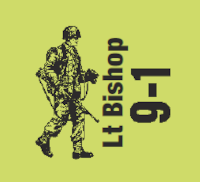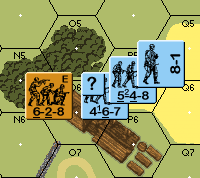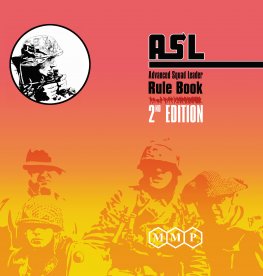
A user asked a question on the ASL Discord. He wanted to know what happened to a stack of units when a leader was lost in Close Combat. In this example, the stack had participating and non-participating units. There is an old Q&A applicable to the question, and another reader provided that. The example in the Q&A was close but not specific to the original question.
I began digging into the rules considering the original question looking for an answer. The more I dug, the more confused I became. I knew the correct answer, at least as I understand how to play the game. I could even find an example that supported the answer, but what I couldn’t find was an explicit rule covering the topic. The whole argument rests on what “In CC” means. Sadly, it means different things depending on where it appears in the rule book.
The Situation

The 6-2-8 advances into CC. Despite all the modifiers (-3!) there is no Ambush. The German player stacks the 8 -1 with the 5-4-8 and opts not to attack with the Concealed 4-6-7. On the other side, the Russian player opts to attack the 8 -1 / 5-4-8 stack. The German attack yields no results. The Russian attack eliminates the 5-4-8 and crucially, the 8 -1. Does this generate a Leader Loss Morale Check (LLMC)?
Rules Dive

A10.2 states “For each leader eliminated … all other friendly Personnel units with a currently lower Morale Level and in the same Location … must take a LLMC [EXC: Riders (13.52, D15.55), Passengers (D6.651), Climbers (B11.42), and units at a different level (2.8), or in CC (11.141) neither take nor cause LLMC/LLTC (as a result of their breaking or elimination). …]” This is the first appearance of “In CC”. Sadly, the index does not define “in CC” means so there is no definitive answer. Does it mean “when attacked in CC”? Maybe “In Melee”? Perhaps both? Something else?
Historical Q&A
Another player asked a similar question in the past., Perry ruled such units were not immune to a Leader Loss Task Check (LLTC)/LLMC.1 Later, the question was asked again and Perry reversed course, stating units Locked in Melee are immune, but not merely units under a CC counter.2 It seems even Perry struggled with this a bit.
Reading the original Q&A in the footnotes, these speak to a Melee. This is not exactly the situation depicted. There is even an example in the Close Combat Resolution depicting how to resolve this in Melee.
From this, we could infer “In CC” means “In Melee” but it isn’t entirely clear so we keep digging.
Close Combat Rules

A11.141 says units in CC never take a LLMC/LLTC. There is that “in CC” phrase again. This time, the phrase appears in A11.1x covering Resolution of CC. Interestingly, A11.15 Melee is a sub-paragraph in this section. A11.15’s appearance here implies Melee is merely CC resolution. And it is here we see what “In CC” means.
We resolve CC by making a DR on the A11.11 Close Combat Table. “In CC” should be regarded as “attacked in CC” or “attacked on the CC table”. This includes attacks against enemy Infantry and vehicles. This interpretation is verified in A11.13 which states “Each Gun/SW counter possessed by a unit eliminated in CC may also be eliminated if the Original colored dr of that CC DR is a 1.” Since SW are eliminated both before and after Melee has formed, “In CC” cannot mean “In Melee”.
Perry Sez

Perry received the original question as a Q&A and replied “The 8-1 leader’s elimination does not cause a LLMC (A10.2).”3 This leaves us with two separate Q&A, one covering before a Melee forms and one covering after a Melee forms, each giving the same answer. And thus, we can see the intention of the rule as Perry interprets it. Sadly, I still think “In CC” means more than one thing and it takes contextual clues to sort it out, but fortunately the outcomes are the same, regardless.
A unit attacking in CC NEVER takes or CAUSES a LLMC/LLTC. In the example, the German player stated his intention to attack with the 8 -1 in CC. When it was subsequently eliminated, per A10.2, it cannot cause an LLMC. Had the CC DR been a Casualty Reduction which eliminated only the leader, the 5-4-8 would not take an LLMC either. Not only is it covered by the “eliminated units do not CAUSE an LLMC”, it is further covered by A11.141 (“Units in CC never take LLMC/LLTC).
How I See It

In all the time I have played ASL, I have always played it as stated here in this article. I am sure I learned it from another player as I am not entirely certain I got there from reading the rules. My understanding of “In CC” meaning “CC Resolution” came only after looking at this question and chatting about it with a friend. I think the argument is a little weak, but I can at least get there from here where I could not before I started. I would still like to see some errata or a Tips From The Trenches in the future defining “In CC” as I think it would clarify the rules.
Simply stated, the rules as intended are: A leader eliminated by a CC attack never causes a LLMC. Units conducting a CC attack or in Melee are never subject to, or cause, a LLMC/LLTC. If you take nothing else away from this, take those two sentences.
I hope this helps. Until next time.
A. No, they are not immune. [Letter151]
A. Units locked in Melee are immune, but not units merely under a CC counter. (Note: this Q&A invalidates an older Q&A on the subject [A11.141 - reference Letter151].)

